Begonia Rex ‘Escargot Begonia’ Care and Grow (2023)
Begonia Rex, well-named “King Begonia,” is a favorite plant for people who love indoor plants. This plant king comes from the green land of Southeast Asia. People are amazed by its beautiful leaves and unique look.

Begonia Rex is a plant from the family Begoniaceae. It has big, bright leaves in many colors and complex designs. What makes this begonia different is its amazing variety; from the beautiful twirls of the ‘Begonia-Rex Escargot’ to the deep, strong leaves of the ‘Begonia-Rex Black,’ each type shows nature’s best art skills.
| Common Name | Rex Begonia, King Begonia, Painted-leaf Begonia, Escargot Begonia |
| Scientific Name | Begonia rex |
| Family | Begoniaceae |
| Origin | Southeast Asia and Northeast India |
| Plant Type | Perennial herbaceous plant |
| Size | Typically 12-18 inches in height |
| Lifespan | Perennial |
| Leaf Colour | Varied (multicolored, often with patterns) |
| Leaf Size | Medium to large |
| Flower | Inconspicuous, grown for foliage beauty |
| Light | Bright, indirect light |
| Water | Keep soil consistently moist, avoid waterlogging |
| Soil | Well-draining soil |
| Temperature | 60-75°F (15-24°C) |
| Humidity | High humidity preferred |
| USDA Zone | 10-12 |
| Fertilizer | Balanced liquid fertilizer every 2-4 weeks during the growing season |
| Propagation | Stem cuttings, leaf cuttings |
| Pruning | Prune for shape and size control |
| Pests | Aphids, mealybugs, spider mites |
| Toxicity | Toxic to pets if ingested |
| Uses | Indoor ornamental plant, adds beauty to interiors |
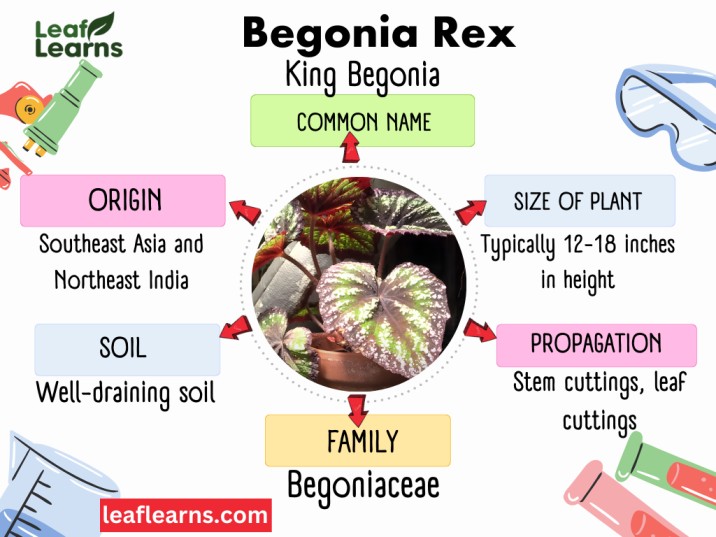
Contents
- 1 What’s Unique About Escargot Begonia?
- 2 Painted leaf Begonia/Begonia Rex Care Indoor
- 3 Begonia Rex Propagation
- 4 Where is the Best Place to plant begonia rex?
- 5 When and How to Plant Rex Begonias
- 6 Pruning
- 7 Potting and Repotting
- 8 How Do I Get my Rex Begonia to bloom?
- 9 Growth Rate and Size
- 10 Appearance
- 11 Begonia Rex Flower
- 12 Foliage
- 13 Fragrance
- 14 Underwatering And Overwatering
- 15 Common Pests and Diseases
- 16 Problems and Solutions
- 17 Is Begonia rex toxic to humans?
- 18 Is Begonia rex toxic to cats?
- 19 Begonia Rex Varieties/Types
- 20 What Are the Uses of Rex begonia?
- 21 Escargot Begonia: Maintaining Health and Vibrancy
- 22 Exploring the Diversity: Captivating Varieties of Escargot Begonia
- 23 FAQs
What’s Unique About Escargot Begonia?
Coming from a place full of tropical charm, the Begonia-Rex grows well in warm and wet places. Its special looks, plus the power to fit in with indoor places, make it a great pick for decorations.
Painted leaf Begonia/Begonia Rex Care Indoor
How Much Light Does an Escargot Begonia Need?
Summer: These green superstars enjoy bright but indirect sunlight. Imagine sunlight coming through tree branches – think of mornings by east-facing windows or afternoons under light curtains.
Sunshine, however, is not good. It’s like having a bad sunburn at a beach event.
Winter: When days get shorter, these pretty tropical plants prefer less bright light. Windows that face north or light near windows facing south become their warm spot in winter. Think warm fire, not bright lights.
Springtime: As days get longer, slowly let your begonia see more light. Imagine it like slowly getting used to a bright spring picnic after spending a warm winter inside.
Autumn: The golden colors of fall copy their best light – warm and spread out. Windows that face east are the best buddies, giving subtle morning sun without the afternoon heat.
How Often Should I Water begonia rex?
Summer: Picture a beach party with lots of sun. Your begonia needs water often, like drinks in the sun. Try for wet dirt, not too wet, like a wrung-out sponge. Check every day and water when the top inch feels dry.
Winter: As days get shorter, your begonia gets cold like a nice cabin in the woods. Its water needs to calm down, like drinking hot chocolate near the fireplace. Water when the top 2 inches of dirt feels dry to touch.
Springtime: When days get longer, your begonia extends and wakes up like a sleepy butterfly coming out of its shell. Little by little, make watering happen more often.
Autumnal: See fall as the time to gather your begonia. We need to use less water, like switching from cold tea to hot cider. Wait until the first two inches of dirt become dry before you water it again.
Begonia Rex Soil mix
Summer: When it’s sunny, our tree needs light and soil that drains well. Picture a sandy beach that gets dry fast after water, keeping the soft roots content and full of air. A potting mix made for begonias or African violets from the store works great.
Winter: When days get shorter, these beautiful plants from the tropics like a little extra soil that keeps moisture. Imagine a warm log cabin with slightly wet moss on the floor still able to breathe, but keeping some dampness for the chilly days.
Adding a little bit of perlite or vermiculite to your normal mix is the perfect way to make it ready for winter.
Springtime: As plants grow, your begonia needs soil that isn’t too poor. Imagine a wet forest ground after spring rain, with lots of living things and food for plants.
Autumn: When fall comes and the air is nice, your begonia needs that light, well-draining summer dirt again. Imagine it like changing back to your summer sandals after the winter boots.
Temperature Requirement
Summer: These amazing tropical flowers like hot days, best at 70°F to 80°F (21°C to 27°C).
Imagine relaxing by the pool in the shade when it’s warm but still safe from intense sun. Stay away from cold air conditioners, they’re like sudden ice wind at a beach party.
Winter: When it gets cold, your begonia likes a little cooler. It’s best between 60 to 65 degrees (16 to 18 Celsius). Picture a comfortable cabin with soft heat. Keep them away from windows and fireplaces, like not sitting near a roaring fire after playing with snowballs.
Springtime: As the days get warmer, slowly make it hotter with more sunlight. Autumnal: The fall days ask for cooler temps again, about 65°F to 70°F (18°C to 21°C).
Humidity Requirement
Summer: Imagine a fun dance party in a hot rainforest – that’s the perfect place for Rex begonias!
Try for 50-60% humidity, like a misty morning near a hidden waterfall. Put them together with other plants that like humidity or put them on trays filled with water and stones.
Winter: As the air gets drier, these leafy stars adapt their hopes. 40-50% humidity is their warm winter blanket. Make sure they don’t get near heat vents or radiators, those things that make the air dry.
Spring: When days get longer, at the same time it gets hotter and more humid. Slowly go up to 50-60%, like the soft spray of springtime awakening.
Autumnal: The gold colors of fall are similar to the perfect humidity – comfortable and steady. Try to reach 45-50%.
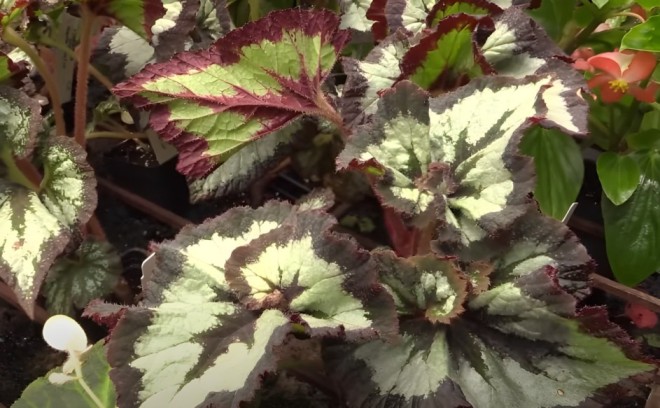
What is the Best Fertilizer for begonia rex?
King Begonia should be grown using a balanced solution, and water-soluble fertilizer like 10-10-10 is appropriate for it. Apply it every 2-4 weeks throughout the growing season, and that your soil stays consistently moist but drain well.
Summer: When your showy begonia is on display, give it a light food that dissolves in water about every two weeks.
Winter: When days get shorter and plants stop growing much, stop using fertilizer. Spring: When the sun starts to shine, begin light feeding every month again.
Autumn: As days get shorter, reduce your use of fertilizers like how sunlight decreases. Once a month turns into twice every two months.
Begonia Rex Propagation
Can You Grow a begonia Rex From a leaf?
Rex begonias practically beg to be multiplied. Their leaves hold the power of life, waiting to sprout into independent plantlets. Forget seeds and complicated techniques, all you need is a single leaf and a dash of plant parenting magic.
Gather Your Tools
- A sharp knife or pruners
- Moist potting mix
- Small pots or planters
- Clear plastic bag (optional)
Step 1: Choose Your Champion
Choose a healthy, big leaf from your Rex begonia. Avoid anything yellowing or damaged. You can cut a big leaf into parts, and each part could have the chance for new life.
Step 2: Make the Cut
With your clean knife, cut the big veins of the leaf into parts about 1-2 inches long. Keep in mind, every vein is important for the growth of a new plant!
Step 3: Pot Your Tiny Treasures
Put wet planting soil in your pots and carefully place the leaf cuttings, with the veins facing down. Don’t put them too far in the ground, just push them a little into dirt.
Step 4: Create a Humid Haven
Optional, but oh-so-helpful! Spray the leaves and cover the pots with a see-through plastic bag, making a small greenhouse. This keeps the wetness level up, making those little plantlets grow.
Step 5: Patience is Key
Now, the waiting game begins! Put your pots in a sunny area with no direct sunlight and keep the dirt wet all the time. In a short time, small green bumps will appear at the bottom of the leaves. These are like shy plant babies just poking out.
Step 6: Let the Sunshine In
When the little plants have a few leaves, slowly take off the bag or stop using it. They’re ready to take on the world! Make the dirt wet and give them light that’s bright but not too strong.
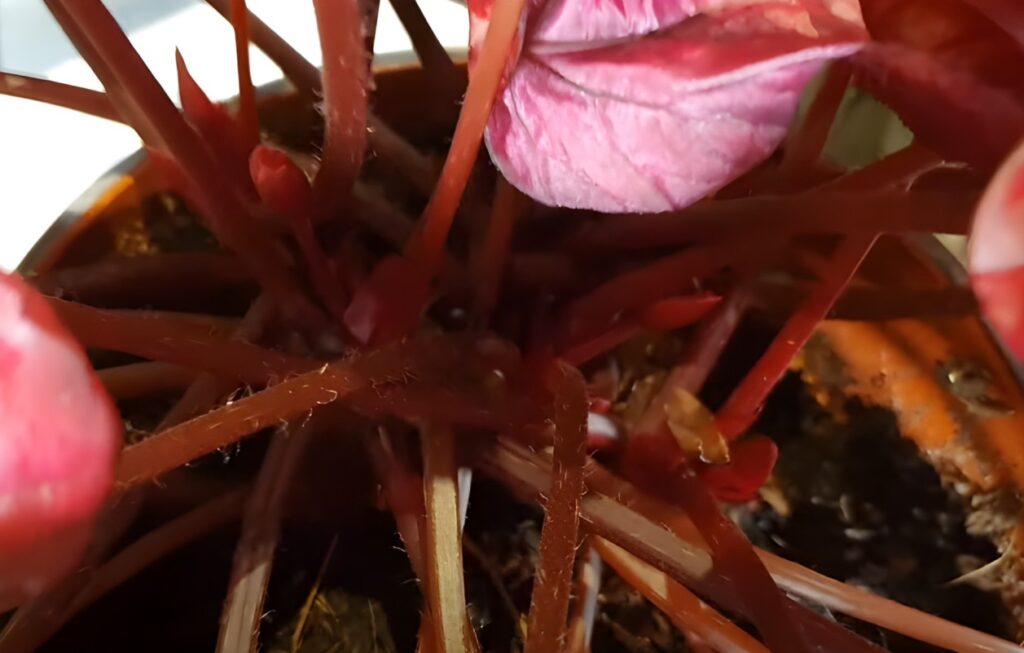
- Picture your Rex begonia like a king (or queen) having hidden treasure – its rhizome, a thick and underground stem that holds the secret to copying more plants. Here’s how to turn one into two (or more!):
- Spring Awakening: Wait until spring when your begonia is full of life to prevent making it stressed.
- Pot Unboxing: Carefully take the plant out of its pot and wipe off extra dirt.
- Rhizome Rendezvous: Search for the crown where the stems touch the rhizome. Slowly separate the parts, making sure each one has good roots and at least one bud. Clean your knives between cuts to stop germs from spreading.
- Potting Palace: Put each part of the rhizome in its own pot filled with good draining pot mix. Give them water carefully, and put them in a place with sun but not too strong.
- Royal Treatment: Do not let the soil be too dry and often spray water on the leaves until new growth starts. Watch your plant babies thrive!
How to Propagate Begonia rex in Water
Select Healthy Cuttings
Select healthy Escargot Begonia stems with one or two nodes, where leaves are attached.
Prepare the Cuttings
Cut a 4-6 inch section of stems with clean, sharp scissors or pruning shears that have at least one leaf and a node.
Remove Lower Leaves
With regard to the use of a cutting, remove leaves from its lower part and leave only two or three ones on top.
Place in Water
Fill a clean glass or jar with cool water at room temperature.
Dip the cut end of the Escargot Begonia cutting into water, where all parts should be submerged in it.
Change Water Regularly:
Change the water after a few days so that it remains clean and oxygenated. This reduces microbial growth.
Provide Indirect Light
Place the container in a bright, shaded area. Do not place the cuttings under direct sunlight, as it may be too intense.
Wait for Roots to Develop
In a couple of weeks, you should see roots developing out from the nodes. The cutting is ready for planting once its roots are a few inches long and well-developed.
Transplanting
Transplant the rooted cutting into a well-draining potting mix with care. The soil should be kept moist at all times but not overly wet.
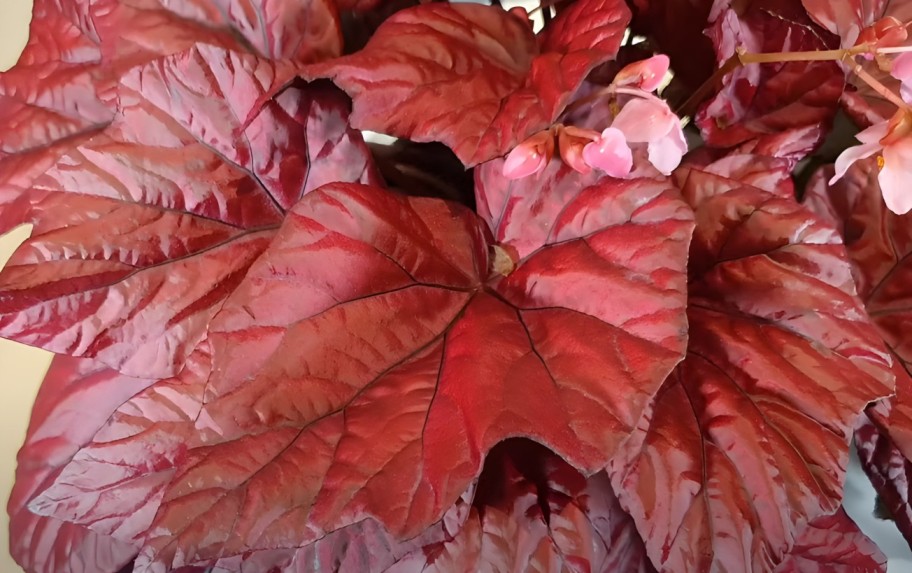
Where is the Best Place to plant begonia rex?
Indoor Oasis: Windows facing east give them morning light, like the soft rays under a rainforest tree cover. Imagine little eating spots or rooms with lots of sunlight – perfect for enjoying their bright designs.
Humid Hideaway: Kitchens and bathrooms, with their steam-filled atmosphere, turn into cozy hiding places for these water-loving pretty things.
Think putting baskets with plants near the shower or on bright counters – like having green light decorations to make it feel more jungle-like.
Summer: Balconies and patios, protected from strong afternoon sun, give a little feeling of the tropics. Imagine shade from trees or pergolas with leaves – a green getaway for you and your begonia to have fun in.
When and How to Plant Rex Begonias
Timing is key: Spring and summer are the best times for planting. Try to get temperatures over 60°F, like a hot picnic in the park.
Pot prep: Pick a little pot that lets water out, like a mini stage for your green plant. Put it with potting mix that drains well, think about fluffy clouds to help those little roots.
Planting prowess: Carefully place your begonia roots (those bumpy under-ground parts) just a bit below the ground soil. Think of putting a sleeping kitten to bed, not covering it with sand.
Water wisely: Water your begonia carefully, just like a light rain in the morning. Make the dirt wet all over, not too much, like a well-squeezed sponge.
Bright, indirect light: Look for a place that looks like sunlight coming through green leaves above. No strong sunlight, that’s like stage lights which cook the performance!
Pruning
Cut off any long stems or yellow leaves to make the plant grow fuller.
Don’t be afraid, these small cuts will make your begonia even more beautiful! Also, you can spread the cuttings into new leafy babies – talk about a family get-together with lots of leaves!
Potting and Repotting
- Potting: Pick a pot that is just a bit bigger than the root ball. Make sure it has holes to drain water or begonias will get wet feet they don’t like.
- Try to use clay or terracotta for good air flow, like a cool breeze in a tropical house. A small bowl is best, similar to their flat plant roots – think of it like a place to get sun, not jump in.
- Repotting: When the root starts showing at the pot’s side, it’s time to make it bigger! Gently take off the begonia, untangle its roots without breaking them and settle it into its new bigger home.
- Put in a potting mix that drains well and has air, like soft cotton for its roots to play in.
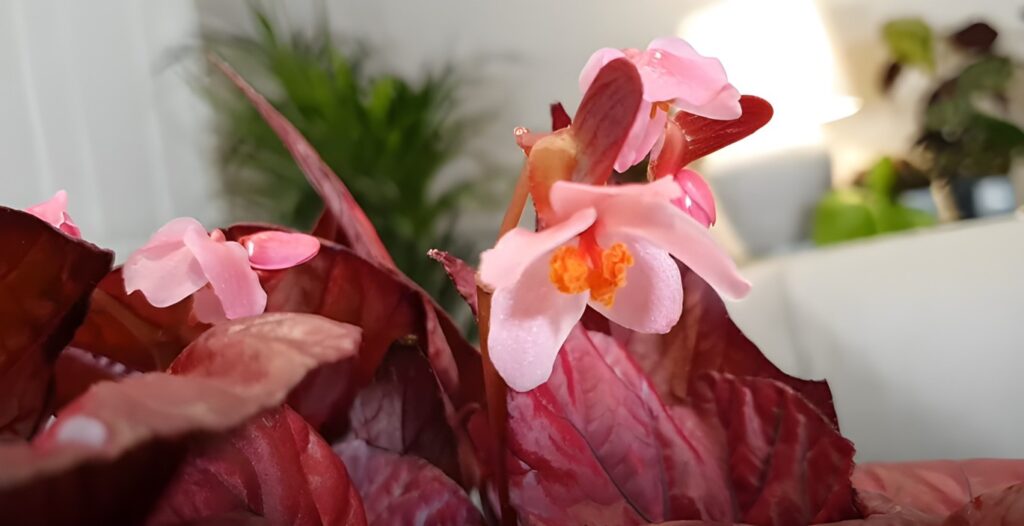
How Do I Get my Rex Begonia to bloom?
- To nudge your Rex towards blooming, try these tips:
- Bright, indirect light: Copy their jungle’s ground level with shaded light, not strong sun.
- Balanced fertilizer: Give a little food in spring and summer to make flowers stronger.
- Moderate humidity: Try to reach about 50%, spraying the leaves or using a stone tray.
- Pinch off buds: Sometimes, putting a lot of effort into making leaves grow can stop flowers from growing. So, carefully take off flower buds at first to help more flowers coming in the future.
Growth Rate and Size
Don’t be fooled by their theatrics, Rex begonias are actually slow growing plants. Picture a gentle waltz, not a hip-hop rhythm. They usually grow 6-12 inches of leafy stuff every year.
When they are fully grown, they can be up to 12-18 inches tall. Think of them as little masterpieces, not big jungle creatures.
But don’t underestimate their impact! Those inches are full of bright colors, textures and patterns that can compete with an artist’s painting.
Appearance
Imagine soft blankets made from green, red and silver threads. Rex begonia leaves have a special magic to them. Their shapes change from heart-like to wavy swirls, each a tiny spot for nature’s art work.
Some have spots, others look like sea shells. Metal lines in some glimmer like hidden treasures. Forget about the dull green plants – these leaves are like paintings in motion.
Begonia Rex Flower
When leaves are the main focus, Rex begonias can sometimes bloom. Small groups of pink, white or yellow flowers stick out from the leaves but they act more like shy appearances than big displays.
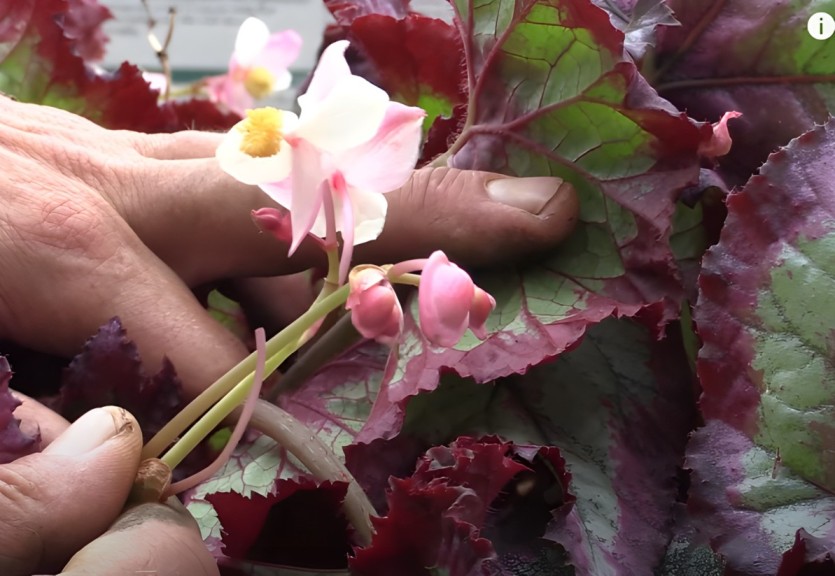
The real excitement is with the leaves, those colorful works of art that grab attention all year long.
Foliage
Different types of leaves have different sizes. Some can get to 6-8 inches big, while others stay small and fun. Shapes come in lots of kinds, from simple heart shapes to curly swirls and long ovals.
And the colors? Oh, the colors! A rainbow shines on every leaf, with green colors mixing with red ones. There are silver lines that look like secrets and maybe bronze or chocolate tones make it more interesting.
Fragrance
Unlike their smelly family members, Rex begonias hide their smell. You don’t need things like sprayers or room smellers here – their beauty depends only on what we can see. What they don’t have in smell, they make up for with amazing textures and fascinating patterns.
Underwatering And Overwatering
| Symptoms | Underwatering | Overwatering |
| Soil Condition | Dry soil that feels parched to the touch. | Soggy, waterlogged soil with a foul odor. |
| Leaves | Drooping, wilting, and crispy edges. | Yellowing, mushy leaves, and root rot potential. |
| Solution | Increase watering frequency. | Adjust watering intervals; improve soil drainage. |
| Frequency | Check soil regularly; water when dry. | Allow soil to partially dry between waterings. |
| Root Health | Roots may become brittle and stunted. | Roots prone to rot and fungal infections. |
Common Pests and Diseases
Here’s a heads-up on the most common pests and diseases to keep an eye out for:
Pest
- Mealybugs: These soft white animals like to eat the juice from your begonia’s leaves, making them limp and covered in stickiness. Search for their fluffy clumps in gaps and leaf bottoms.
- Thrips: These little scares make shiny lines and messed up leaves behind them. You may spot them flying near the leaves.
- Spider mites: These tiny bugs make yellow spots and lines on the leaves. Use moisture to make sure they grow well. High humidity is important for them.
Disease
- Powdery mildew: This fungal disease shows up as white dusty spots on leaves. It slows growth and makes your begonia look dirty.
- Botrytis: This gray mold loves to grow in wet places, breaking down leaves and stems. Stop watering from above and make sure there’s plenty of fresh air moving around.
- Bacterial leaf spot: Yellow-ringed spots with water on leaves mean this bacterial sickness. Keep sick plants away from others and don’t throw water on leaves.
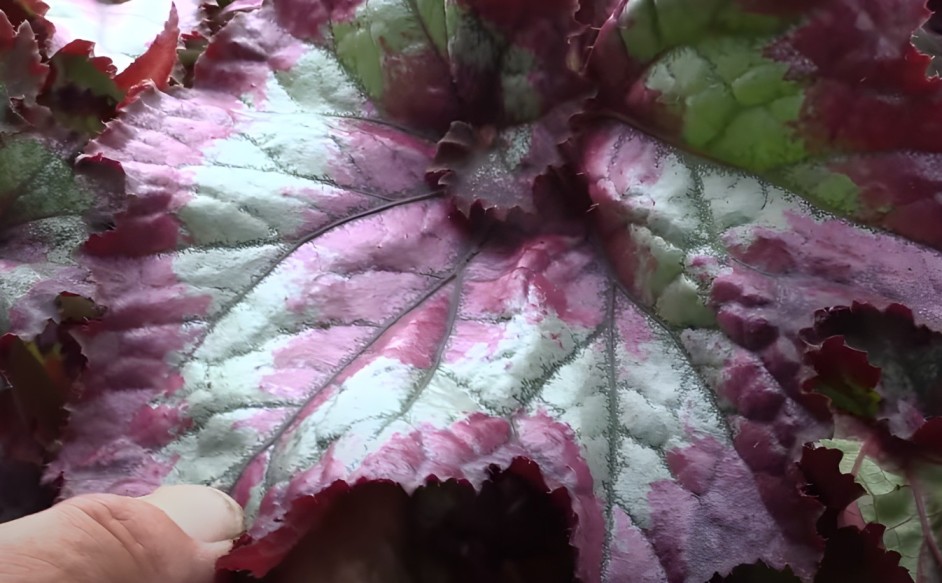
Problems and Solutions
Problem: Yellowing Leaves on Begonia Rex
Solution: Keep water flowing right and don’t give too much to stop rotting roots, a usual reason for yellow leaves in Escargot Begonia. Change how often you water, depending on how wet or dry the soil is.
Problem: Leggy Growth in Begonia-Rex
Solution: Give a lot of light that isn’t direct to help the growth be small and bushy. Turn the plant often to make sure it gets even light, helping it grow nice and equal.
Problem: Pest Infestation on Begonia-Rex
Solution: Watch out for bugs like spider mites and scale. To deal with bug problems without hurting your Begonia-Rex, use a mild insect-killing soap or neem oil.
Problem: Leaf Drop in Begonia-Rex
Solution: Keep the humidity levels steady, especially in dry inside places. Using a pebble tray or often spraying can help stop too many leaves falling off and make the plant healthier.
Problem: Begonia-Rex Fading Leaf Colors
Solution: Make sure your king Begonia gets enough, filtered light. Move it to keep it out of the sun, so its special leaves stay bright in color.
Is Begonia rex toxic to humans?
It is toxic to humans and its juice can make you feel uncomfortable. Stay away from touching eyes and mouth, then wash hands properly after dealing with it.
Is Begonia rex toxic to cats?
This plant is toxic to Cats and dogs and this plant has stuff that can make pets sick in their tummy if they eat it. Keep these bright plants away from reach to stop interested biting.
Begonia Rex Varieties/Types
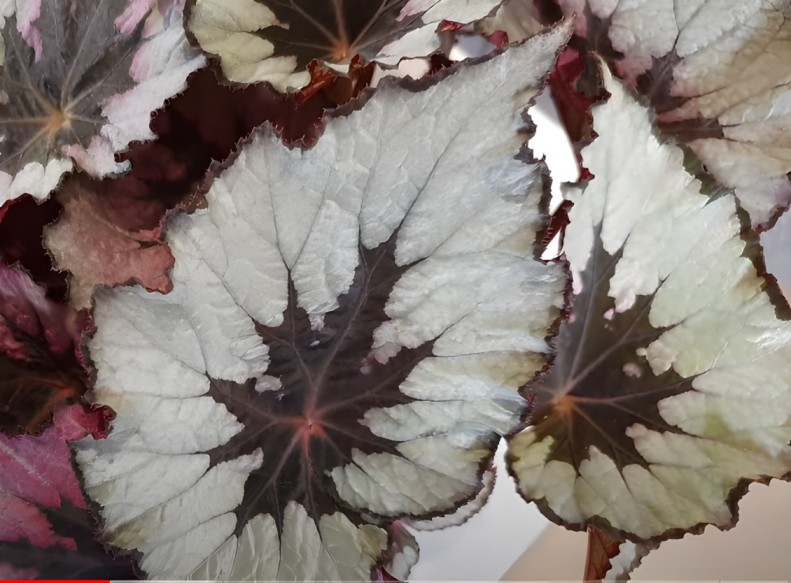
Begonia-Rex Arctic Twist
Discover the spellbinding designs of the Arctic Twist. Its leaves move beautifully, making a lovely show that brings class to any space.
Begonia Rex Salsa
Fill your room with bright energy by using the strong and cheerful colors of the Salsa type. Its moving leaves give a fun feeling to your indoor garden, making it a great pick for people who love plants.
Begonia Rex Escargot
Love the fun look of the Escargot which has leaves that go around like a snail’s shell. This special type makes your collection interesting and fun.
Begonia-Rex Black
Explore the charm of darkness and drama with Rex Black. Its green leaves add a hint of mystery and class, making it an elegant pick for those who love plants.
Begonia-Rex Angel Wing
Make your indoor garden soar with the Angel Wing type. Its beautiful leaves give a feeling of kindness and cleanliness, making it a nice part to your plant heaven.
Begonia-Rex Silver
Make your area pretty with the magical beauty of the Silver kind. Its shiny leaves bring beauty and class, making an impressive centerpiece in any room.
What Are the Uses of Rex begonia?
- Stunning Indoor Decor: Make your inside places look better with the pretty beauty of Begonia-Rex.
- Versatile Aesthetic: No matter if you want a modern, old-fashioned or mixed-up look inside your home.
- Natural Air Purifier: King Begonia is not just pretty. It also makes the air in your home better and helps you feel good.
- Low Maintenance Beauty: Begonia-Rex is great for plant lovers. It’s easy to take care of and good if you just want a few plants at home without lots of work.
- Unique Foliage Patterns: King Begonia has leaves with fancy designs and many colors, making it interesting to talk about.
- Mood-Boosting Presence: Research has found that keeping indoor plants such as Escargot Begonia can help improve your mood and lower stress.
- Compact Size, Big Impact: Even though it’s small, the strong leaves of Escargot Begonia catch your eye.
- Gift of Beauty: Give a Begonia-Rex as a present to share the happiness of nature’s beauty.
- Indoor Garden Variety: This plant has many different types that give you a lot of choices for making an indoor garden in your own way.
- Photogenic Elegance: If you like taking photos of your indoor garden and putting them on social media, Begonia-Rex’s good looks make it very popular in your plant posts.
Escargot Begonia: Maintaining Health and Vibrancy
King Begonia is a stunning and popular choice among indoor plant enthusiasts. Proper care is essential to maintain the health and vibrancy of these unique plants. When cultivating begonia-rex indoors, ensure they receive bright, indirect light, as direct sunlight can scorch their delicate leaves.
The soil should be well-draining, and the plants prefer consistent moisture without waterlogged conditions. Begonia-rex thrives in a humid environment, making it beneficial to place a tray of water or use a humidifier nearby.
During the growing season, provide a balanced liquid fertilizer every 2-4 weeks, but reduce feeding in the winter when the plant is dormant. These care tips apply whether you’re tending to your begonia-rex in the UK, NZ, or any other region.
Exploring the Diversity: Captivating Varieties of Escargot Begonia
The beauty of begonia-rex extends beyond its care regimen, as there are numerous captivating varieties to choose from. Whether you fancy the mesmerizing patterns of the Escargot Begonia arctic twist or the bold colors of the begonia-rex salsa, the diversity in these plants is truly remarkable.
Other intriguing options include the king begonia escargot, featuring spiral-shaped leaves, and the king begonia black, known for its dark, dramatic foliage. With varieties like the begonia-rex angel wing and begonia-rex silver, the possibilities for creating a visually stunning indoor garden are endless.
Each variety may have specific care requirements, so it’s essential to tailor your approach based on the unique characteristics of the king begonia you choose. Whether you’re a seasoned begonia enthusiast or a beginner, exploring the rich variety of king begonia cultivars can be a delightful journey in itself.
FAQs
How do you care for a begonia rex?
A bright, indirect light source, consistent moisture, and a humidity level of 50-60% should be provided. You should fertilize your plants every 2-4 weeks during the growing season.
Is rex begonia full sun?
There is no need for direct sunlight on rex begonias, since direct sunlight can scorch their delicate leaves. They prefer bright, indirect light.
Is begonia rex an indoor plant?
In fact, king begonia is a plant that thrives in a controlled environment such as a home, since it is sensitive to changes in temperature and light levels.
Do rex begonias like water?
Rex begonias prefer consistent moisture in their soil. Ensure that the top inch of soil is dry before watering, but do not let it become waterlogged.
Why is my Begonia rex/Begonia escargot dying?
You may overwater, not have enough light, or experience extreme temperature fluctuations. Make sure that watering is adjusted, lighting conditions are improved, and that a stable environment is maintained.
Are rex begonias easy to grow?
Although they can be challenging to care for due to their special needs, rex begonias make stunning houseplants if given the right care.
Is begonia rex poisonous?
A king begonia plant can be toxic if consumed. You should keep it out of reach of children and pets.
How do you keep rex begonias red?
For rex begonia leaves to retain their vibrant red coloration, provide adequate light and maintain a consistent humidity level.
Does begonia rex flower?
There is no doubt that rex begonias are capable of producing small, inconspicuous flowers. Their foliage, however, is primarily grown for its color and uniqueness.
What is rex begonia called?
The striking and colorful foliage of the Rex begonia also makes it known as the painted-leaf begonia.
Can I propagate begonia rex?
You can propagate rex begonias through leaf cuttings or division. Maintain high humidity when planting cuttings in well-draining mixes.
What is the best way to water begonia rex?
Make sure the soil on top of your Escargot Begonia is dry before watering. Root rot can be prevented by using room temperature water and avoiding waterlogging.
How do you make begonia rex bushy?
The growing tips of Escargot Begonia should be pinched back regularly to encourage bushiness and lateral growth.
What is the difference between begonia and begonia rex?
“Begonia” refers to a large genus of plants that includes many species with different characteristics, whereas “Begonia rex” refers to a specific species with ornamental foliage.
Do rex begonias prefer shade?
Rex begonias can withstand a certain amount of shade provided the light is bright and diffused. But excessive shading can lead to leggy growth.
What does a rex begonia look like?
Rex begonia is characterized by bright and variegated foliage with interesting patterns as well as colors, which makes it one of the more popular types for decorative indoor plants.
Are begonia rex easy?
King Begonia may be a bit hard since their care is all very specific, but if you give them the right amount of light, water and humidity then they can thrive in an indoor setting.
What kind of Begonia is escargot?
Begonia escargot is one of the varieties of rex begonias which mainly consists in swirling or snail-shaped leaves and characteristic silver spots.
How do you care for escargot begonias?
Escargot begonias should have bright, indirect light provided to them; it is necessary to ensure that the soil stays consistently moist and humidity remains high.






